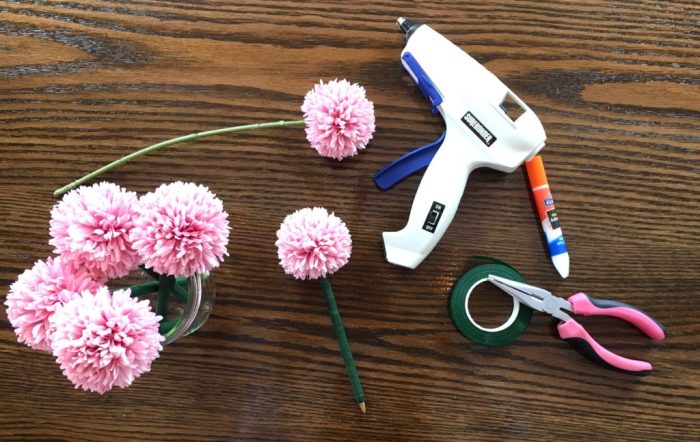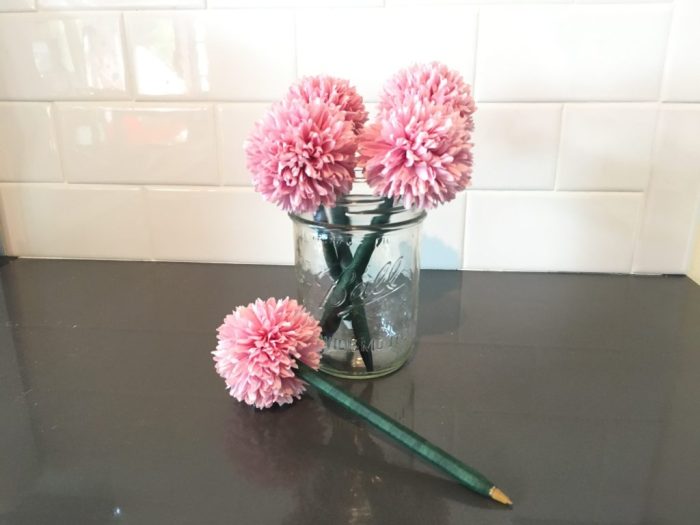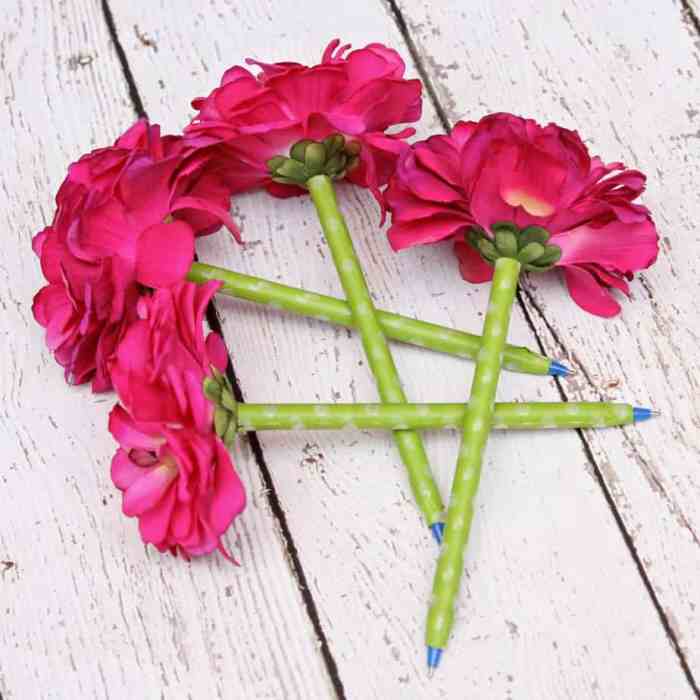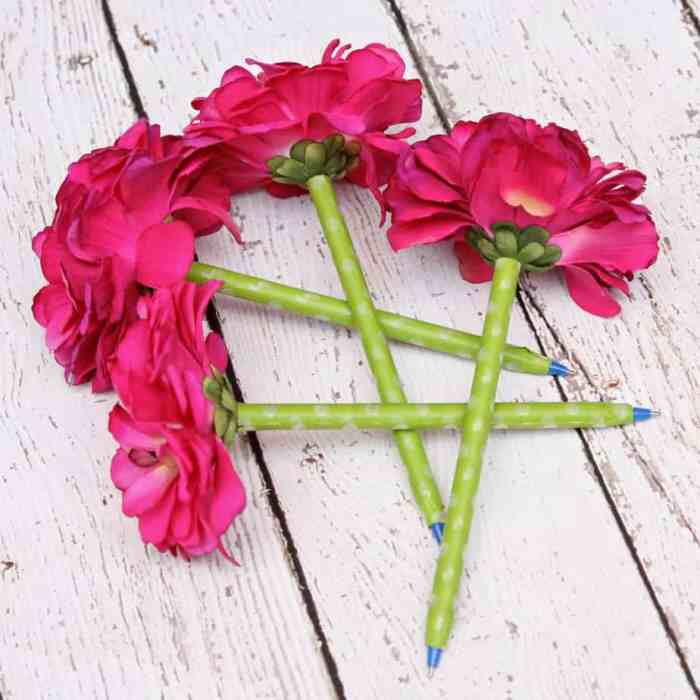DIY flower pens offer a unique and creative way to transform beautiful blooms into functional writing tools. This engaging craft allows you to express your artistic side while creating personalized gifts or simply adding a touch of nature to your everyday writing experience. With a few basic materials and a little patience, you can create stunning flower pens that are both beautiful and functional.
The process of making flower pens is a journey of discovery, from selecting the perfect flower to adding the finishing touches. You’ll learn about different flower types, their suitability for pen-making, and techniques for preserving their natural beauty. This project also encourages mindfulness and appreciation for the natural world, as you transform delicate petals into something truly special.
Introduction to DIY Flower Pens

Transforming nature’s beauty into functional art, DIY flower pens offer a unique and rewarding craft project. Combining the elegance of flowers with the practicality of writing tools, these pens create a delightful fusion of artistry and everyday utility.
The process of crafting flower pens involves preserving natural materials and transforming them into elegant writing instruments. This creative endeavor appeals to those seeking unique, personalized gifts, or those who enjoy exploring artistic expression through unconventional mediums.
Materials and Tools
The basic materials required for creating flower pens are readily available and can be sourced from local craft stores or online retailers. These include:
- Fresh or dried flowers: Choose flowers with sturdy stems and petals that can withstand the drying process.
- Clear epoxy resin: This serves as the binding agent, encasing the flowers and providing durability to the pen.
- Pen blanks: These are pre-shaped pieces of wood or acrylic that form the base of the pen.
- Pen making tools: This includes a drill, sanding tools, and a pen turning lathe (optional).
- Other supplies: This includes gloves, measuring cups, mixing sticks, and a heat gun (for curing the resin).
Benefits of Making Flower Pens
Creating flower pens offers a range of benefits, including:
- Creativity and Expression: Flower pens allow for artistic expression through the selection of flowers, colors, and designs.
- Mindfulness and Relaxation: The process of crafting flower pens encourages focus and attention to detail, fostering a sense of calm and mindfulness.
- Upcycling and Sustainability: Utilizing natural materials and transforming them into useful objects promotes sustainability and reduces waste.
- Personalized Gifts: Flower pens make unique and thoughtful gifts for special occasions, showcasing creativity and personal touch.
Adding Ink and Filling Mechanisms: Diy Flower Pens
Now that your flower pen is assembled, it’s time to choose the right ink and figure out how to fill it. The ink you choose will affect the writing experience, so it’s important to consider its properties and how it will interact with your pen.
Ink Types and Properties
Different ink types have different characteristics that can affect how your pen writes. Consider the following:
- Water-based inks are generally considered safe for most pens and are commonly available. They dry quickly and are easy to clean.
- Pigment inks are more permanent and less likely to fade, making them suitable for archival purposes. However, they can sometimes clog pens, especially those with fine nibs.
- Dye-based inks are known for their vibrant colors and smooth flow, but they can be prone to feathering and bleeding on certain papers.
- Iron-gall inks are highly archival and fade-resistant, but they can be corrosive and damage some pens. They are best used with pens designed for them.
Filling Mechanisms
There are several ways to fill a flower pen with ink:
- Cartridges are pre-filled ink containers that are easy to insert and replace. They are a convenient option, especially for beginners.
- Converters are refillable cartridges that allow you to use bottled ink. They are more economical than cartridges and offer greater ink variety.
- Dip pens require you to dip the nib into an inkwell to fill the pen. They offer a unique writing experience, but require more maintenance and can be messier.
Ensuring Proper Ink Flow and Preventing Leaks
Here are some tips to ensure your flower pen writes smoothly and doesn’t leak:
- Choose the right ink for your pen. Water-based inks are generally safe for most pens, but it’s always best to check the pen’s manufacturer’s recommendations.
- Use a converter or cartridge designed for your pen. Using the wrong type of converter or cartridge can cause leaks or damage your pen.
- Don’t overfill the pen. Leave some space in the converter or cartridge to prevent leaks.
- Store your pen horizontally. Storing your pen vertically can cause ink to leak out of the nib.
- Clean your pen regularly. This will help prevent ink from clogging the nib and keep your pen writing smoothly.
Inspiring Flower Pen Designs

Transforming everyday objects into works of art is a captivating pursuit, and flower pens offer a unique opportunity to blend functionality with floral beauty. These pens, crafted from natural elements, are not only aesthetically pleasing but also eco-friendly and a testament to creative ingenuity. This section explores a diverse range of flower pen designs, showcasing their intricate details and artistic inspiration.
Flower Types and Pen Structures
The choice of flower type significantly influences the overall design of the pen. The flower’s size, shape, and texture determine the pen’s structure and aesthetic appeal. For example, a delicate daisy might lend itself to a slender pen with a delicate cap, while a robust sunflower could inspire a more substantial pen with a bold design.
- Rose Pens: Roses, known for their elegance and romanticism, inspire a range of pen designs. The petals can be used to create a delicate, flowing pen body, while the stem can be incorporated into the pen’s barrel. Rose pens often feature intricate details, such as a rosebud-shaped cap or a rose thorn-inspired nib. The color of the rose can also be incorporated into the pen’s design, with red roses representing passion and white roses symbolizing purity.
- Lily Pens: Lilies, with their graceful trumpet-shaped flowers, lend themselves to elegant pen designs. The lily’s petals can be used to create a smooth, flowing pen body, while the stem can be incorporated into the pen’s barrel. Lily pens often feature a minimalist design, with the lily’s natural beauty taking center stage. The color of the lily can also be incorporated into the pen’s design, with white lilies representing purity and yellow lilies symbolizing joy.
- Orchid Pens: Orchids, known for their exotic beauty, inspire bold and intricate pen designs. The orchid’s petals can be used to create a unique, textured pen body, while the stem can be incorporated into the pen’s barrel. Orchid pens often feature intricate details, such as a flower-shaped cap or a delicate orchid-inspired nib. The color of the orchid can also be incorporated into the pen’s design, with purple orchids representing royalty and pink orchids symbolizing grace.
Aesthetic Themes, Diy flower pens
Beyond the flower type, the overall aesthetic of the pen can be influenced by various themes. These themes can range from classic and elegant to whimsical and playful, reflecting the artist’s personal style and the intended use of the pen.
- Nature-Inspired Designs: These designs draw inspiration from the natural world, incorporating elements such as leaves, vines, and branches. Nature-inspired flower pens often feature a rustic aesthetic, with a focus on natural materials and textures. The pen’s design may incorporate elements of the flower’s natural habitat, such as a forest scene or a garden setting.
- Geometric Designs: These designs incorporate geometric shapes and patterns, creating a modern and sophisticated aesthetic. Geometric flower pens often feature a clean and minimalist design, with the flower’s form serving as a central design element. The pen’s design may incorporate geometric shapes such as circles, squares, and triangles, creating a sense of balance and harmony.
- Whimsical Designs: These designs are playful and imaginative, often incorporating elements of fantasy and folklore. Whimsical flower pens often feature a whimsical and playful aesthetic, with the flower’s form serving as a starting point for creative interpretation. The pen’s design may incorporate elements of fairy tales, myths, or legends, creating a sense of wonder and enchantment.
Examples of Flower Pen Designs
To further inspire your own flower pen creations, here are some examples of visually appealing and unique designs:
- Rosebud Pen: This pen features a delicate rosebud-shaped cap and a slender barrel crafted from rose petals. The nib is shaped like a rose thorn, adding a touch of whimsy to the design. The pen is painted in shades of red and pink, reflecting the colors of a blooming rose.
- Lily Stem Pen: This pen features a smooth, flowing barrel crafted from lily petals. The stem of the lily is incorporated into the pen’s barrel, creating a natural and elegant design. The pen is painted in shades of white and yellow, reflecting the colors of a lily.
- Orchid Blossom Pen: This pen features a unique, textured barrel crafted from orchid petals. The orchid’s stem is incorporated into the pen’s barrel, creating a bold and intricate design. The pen is painted in shades of purple and pink, reflecting the colors of an orchid.
- Daisy Garden Pen: This pen features a delicate daisy-shaped cap and a slender barrel crafted from daisy petals. The pen’s design incorporates elements of a garden setting, with leaves, vines, and branches adorning the barrel. The pen is painted in shades of white and yellow, reflecting the colors of a daisy.
- Sunflower Spiral Pen: This pen features a bold and geometric design, with the sunflower’s spiral pattern serving as the central design element. The pen’s barrel is crafted from sunflower petals, creating a textured and visually appealing surface. The pen is painted in shades of yellow and brown, reflecting the colors of a sunflower.
Beyond Flower Pens

While flower pens are a delightful DIY project, the world of crafting with flowers and natural elements is vast and brimming with possibilities. Let’s explore other ways to incorporate the beauty of nature into your creations.
Flower-Themed Jewelry
Flower-themed jewelry offers a unique and elegant way to showcase the beauty of nature. You can create stunning pieces using pressed flowers, dried petals, or even resin-embedded flowers.
- Pressed Flower Earrings: Create delicate and charming earrings by pressing flowers between layers of parchment paper and incorporating them into resin molds. These earrings add a touch of natural beauty to any outfit.
- Dried Flower Necklaces: Dried flowers, such as lavender, roses, or hydrangeas, can be strung together with beads or wire to create eye-catching necklaces. This technique allows the flowers to retain their natural color and texture.
- Resin Flower Rings: Resin is a versatile material that can be used to create stunning jewelry. You can encapsulate pressed flowers or petals within resin rings, creating a unique and personalized piece.
Creating DIY flower pens is a rewarding experience that combines creativity, nature, and practicality. With a little effort and imagination, you can create personalized pens that are not only beautiful but also serve as unique conversation starters. Whether you’re a seasoned crafter or just starting out, the world of DIY flower pens offers endless possibilities for artistic expression and personal satisfaction.
Creating DIY flower pens is a fun and creative way to add a touch of nature to your stationery. The process involves using real flowers, which are carefully pressed and then incorporated into the pen’s design. While this might seem like a simple craft, there’s a scientific aspect to it, as the flowers are essentially being preserved. This preservation process is similar to how azacitidine , a medication used to treat certain types of cancer, works by inhibiting the growth of cells.
In the case of the flower pens, the preservation process allows the beauty of the flowers to last longer, much like how azacitidine helps to slow down the growth of cancerous cells. So, the next time you’re making DIY flower pens, remember the fascinating science behind this seemingly simple craft.

